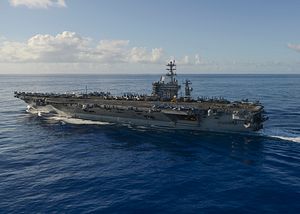The nuclear-powered Nimitz-class aircraft carrier, USS Nimitz, the lead ship of her class, has deployed to the Asia-Pacific region, the U.S. Navy announced on June 22.
The Nimitz strike group consisting of the Arleigh Burke-class guided-missile destroyers USS Howard USS Shoup, USS Pinckney, USS Kidd, and the Ticonderoga-class guided-missile cruiser USS Princeton arrived in the U.S. Navy’s Seventh Fleet area of operations on June 21.
The Seventh Fleet is the U.S. Navy’s largest forward deployed fleet with its area of operations stretching from the International Date Line to the India-Pakistan border; and from the Kuril Islands in the North to the Antarctic in the South.
“While operating on patrol in Seventh Fleet, Nimitz is slated to enhance maritime partnerships and promote peace and stability in the Indo-Asia-Pacific region,” the U.S. Navy statement reads. The USS Nimitz and her escort departed their homeports of Naval Station Kitsap-Bremerton and Naval Station Everett, both located in Washington state on June 1.
“Over the past eight months we have been in a pretty intense training environment, which culminated into just a superb performance during COMPTUEX (Composite Training Unit Exercise),” said Rear Admiral Bill Byrne, the commander of the Nimitz strike group. “We’re looking forward to working closely with our allies and partners in the Indo-Asia-Pacific practicing the skills we gained and enhancing relationships within the region.”
The USS Nimitz was initially scheduled to deploy to the Middle East, but recent tensions on the Korean Peninsula made the U.S. government decide to dispatch the supercarrier to the Asia Pacific region.
The U.S. Navy now operates two nuclear-powered Nimitz-class aircraft carriers in the region.
The Ronald Reagan carrier strike group, operating out of Yokosuka Naval Base in Japan’s Kanagawa Prefecture and currently the U.S. Navy’s only forward-deployed carrier strike group in the Asia-Pacific region, has recently completed a four-day port visit to Singapore.
Earlier this, the USS Ronald Reagan and the Nimitz-class carrier USS Carl Vinson conducted dual-carrier operations off the Korean peninsula in the Sea of Japan in response to North Korean ballistic missile tests. The USS Nimitz is replacing the USS Carl Vinson in Asian waters as the carrier is scheduled to return to its homeport of San Diego, California on June 23.
“The USS Carl Vinson’s deployment was extended by a month due to the volatile security situation on the Korean Peninsula,” I explained elsewhere. “While deployed in the Asia-Pacific region, the aircraft carrier participated in a number of training exercises and conducted patrols in the South China Sea.”
A carrier strike group can consist of up to 12 warships and 75 aircraft.

































